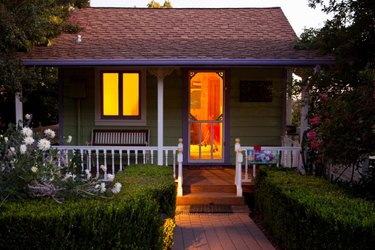
Its short stature and top full of long fronds makes the sago palm a distinctive-looking plant. Despite its name, the sago palm isn't a palm tree at all, but rather a prehistoric conifer plant. These plants are native to tropical islands in southern Japan, but thrive in warm areas of states like Florida, Georgia and Alabama. Considered to be drought resistant, the sago palm can also grow in places like Texas. If you live in an area where they can survive outdoors, consider using them as part of your landscaping.
Driveway/Entryway
Video of the Day
Plant a sago palm at each end of your driveway to give a symmetrical feel to the area. This technique also works on either side of an entryway or at the corners of a patio as a way to add a subtle tropical feel to your outdoor space. You could also place sago palms in large pots to place by an entrance.
Video of the Day
Pool Area
The exotic look and feel of a sago palm makes it a good plant to use around your pool area. You can place one or two sago palms near one corner or edge of the pool and surround them with colorful flowers. Add a taller palm tree behind the sago palms for variety. These plants can also work well around intricate pools that have stone or built-in waterfalls.
Private Escape
Create a small nook in your yard where you can place a lounge chair and retreat to as a private escape. You can use patio pavers or concrete to form a non-traditional shape, like a circle or triangle. Around the edges of this area, place several sago palms that can provide a bit of shade to the chair.
Walkways
Use sago palms to line the sides of a walkway or pathway in your yard. Instead of placing them directly next to one another, leave spaces of 4 to 5 feet in between each one and fill those spaces with lush tropical flowers and greenery.
Wall Concealer
To conceal an unsightly wall or fence, plant rows of sago palms along it. This only works well with low walls or fences because sago palms are very slow growing. Although they can reach heights of up to 15 feet, this takes almost 50 years.